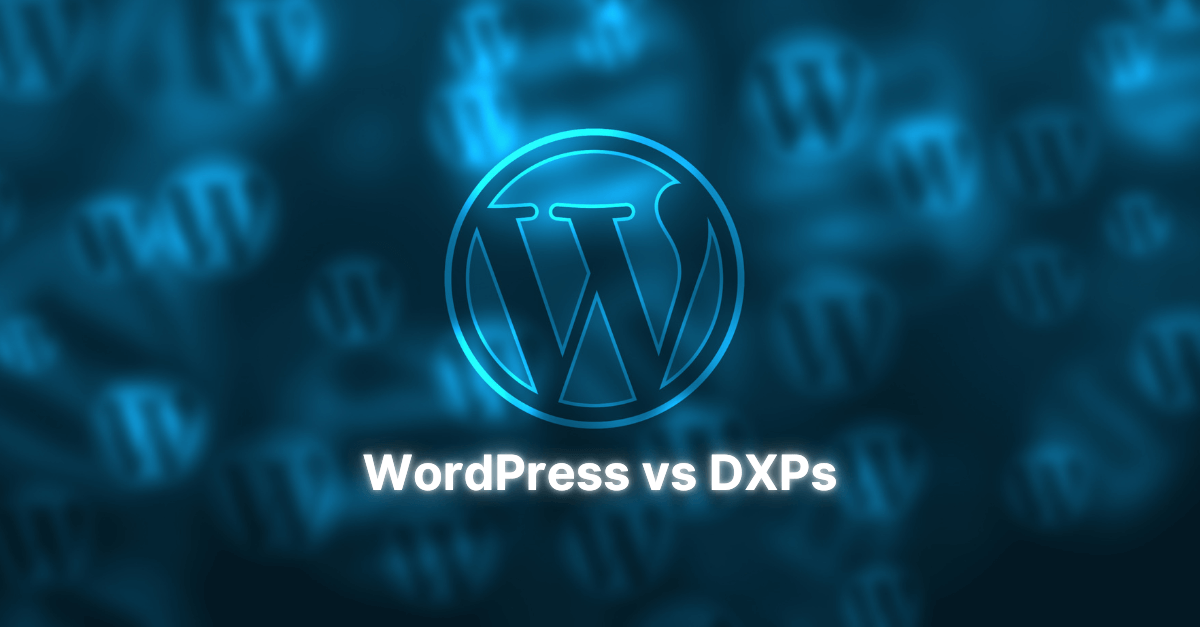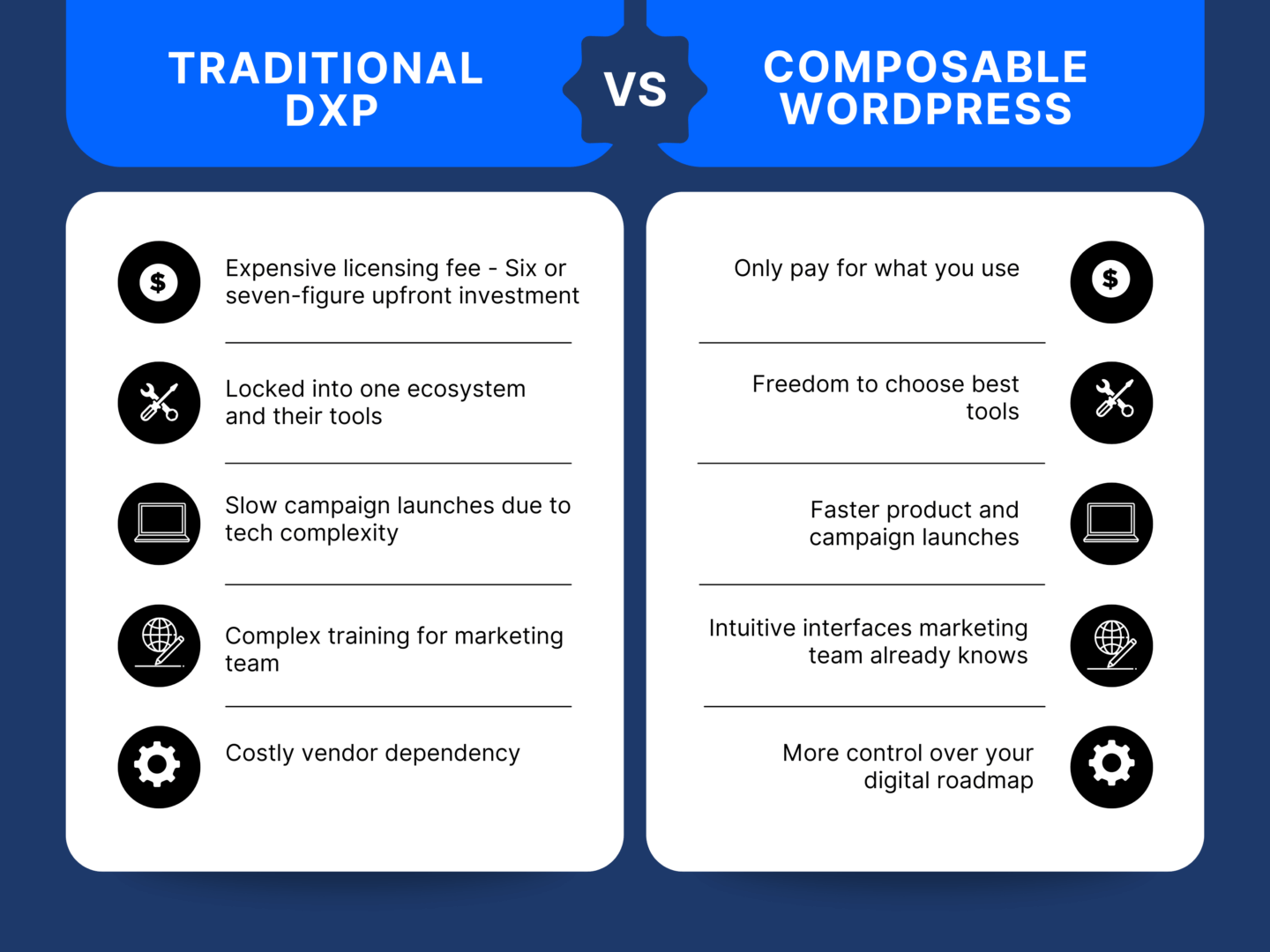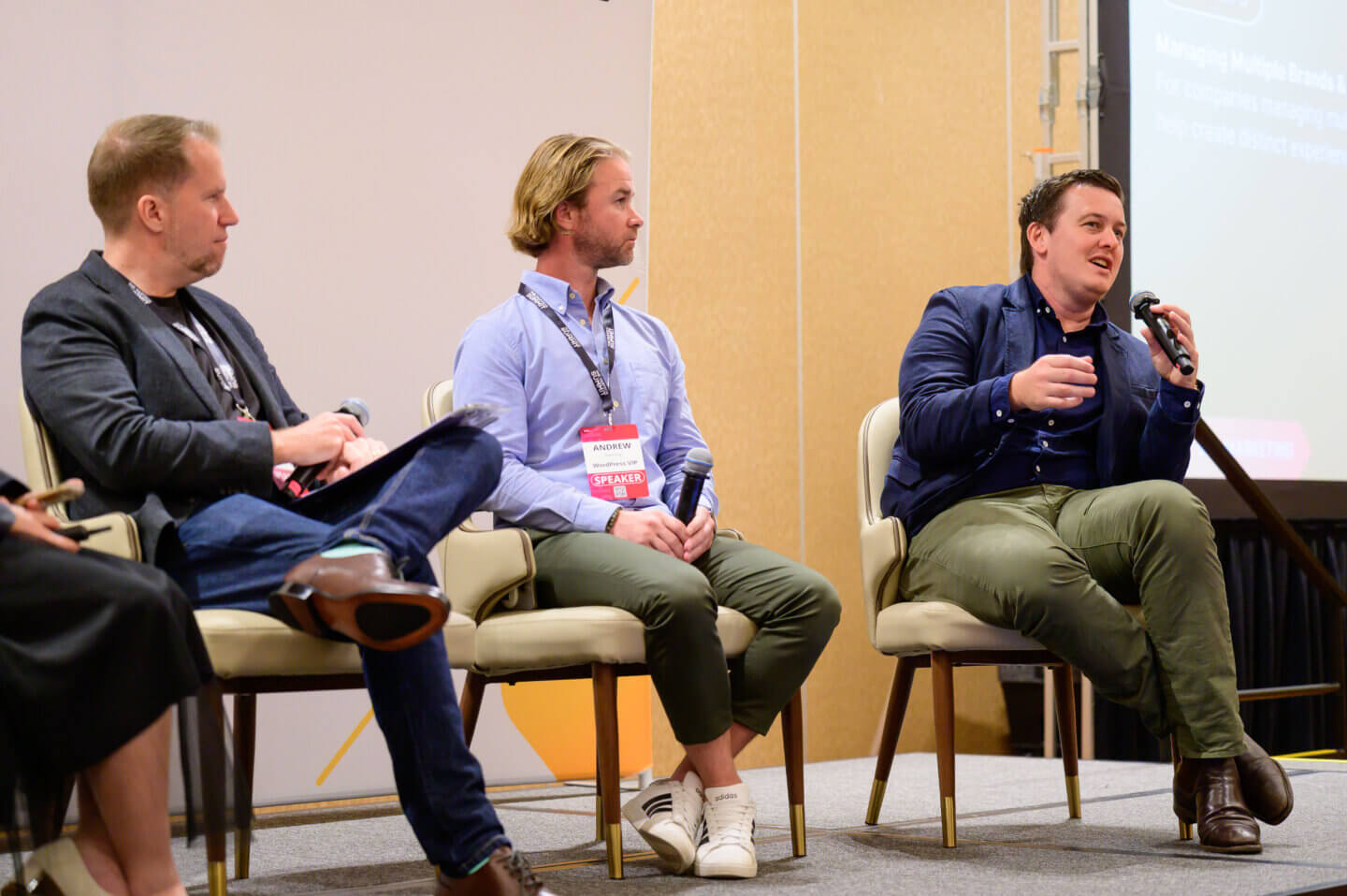
Do You Really Need a DXP?
As a marketing leader, success usually boils down to two goals: attract more visitors and drive more conversions.
For years, traditional digital experience platforms (DXPs) like Adobe and Sitecore have invested millions into convincing businesses that their all-in-one platforms are essential for digital success.
For many marketing teams, the hype hasn’t lived up to the reality.
Instead of greater efficiency, they’re now drowning in tech complexity and locked into expensive contracts, It’s no surprise more teams are starting to ask: is there a better alternative?
This article will explore the idea of composable website technology and explain what you need to know before making your next digital investment.
The Cost of Traditional DXPs
On paper, monolithic DXPs sound appealing: an all-in-one platform promising to handle everything from content management to personalisation. But they can create more barriers than they remove; often slowing down teams at the very moment when speed and flexibility matter most.
- Technology Handcuffs: Your martech stack is limited to the platform’s ecosystem, even when better or more affordable tools exist elsewhere.
- Slow Innovation: Launching a new campaign, trying a new tool, or pivoting strategy can take months of IT approvals and vendor delays.
- High Costs: Enterprise license fees can quickly balloon into six or seven figures — and that’s before factoring in implementation, customisation, and ongoing support.
WordPress vs DXPs

Why Are Marketers Switching to a Composable approach with WordPress?
It’s simple, WordPress allows marketers to build and use what they actually need.
As a marketer, you want control over your marketing roadmap without having decisions imposed by technology teams.
Composable platforms give you back that power. You build a stack that is tailored to your marketing goals, integrating best-of-breed tools around a flexible, open-source core like WordPress. And unlike all-in-one platforms, with composable technology, you only pay for the tools you’re actually using.
What are the platform considerations for marketers?
According to Forrester, digital leaders should evaluate technology investments as key business drivers:
- Time to Market
- New Customer Acquisition
- Site Consolidation & Localisation
- Total Experience – (UX/CX/Employee X) e.g. low code tools
- Brand Consistency (managing multiple brands from a single website)
- Content orchestration
- Omnichannel marketing
Real World Success: Commons Clinic, Konica Minolta Australia, FUJIFILM-X and AusDoc
1. Your Website Is A Customer Acquisition Engine
You can’t fix a broken funnel if your website is the problem.
Your CMS essentially serves as the backbone of your entire digital experience, connecting content, data, revenue, and every audience touchpoint. If you’re like most marketers, you’re juggling dozens of tools and are likely drowning in technical debt and team inefficiencies.
A composable approach flips this script by letting you build a site that fits your existing martech stack — and nothing more. You only pay for the tools you actually need, and they all work seamlessly together. And if you get this part right, you’ll often see your traffic surge, revenue soar and your team output double.
Health tech brand The Commons Clinic is a great example of this. When the marketing team approached The Code Company, they were in the scaling phase and needed a website to drive patient acquisition. The original headless website was failing accessibility tests and was also inaccessible to the SEO team, who couldn’t perform their role without developer support.
By moving to a more traditional WordPress setup with integrated lead capture forms, newsletter sign-ups, marketing automation, and analytics dashboards, control was put back in the marketing team’s hands.
As our website was rebuilt and we ramped up our content development and SEO programs, we’ve seen huge growth in our traffic volume.
Marissa Boevers, VP of Platform Commons Clinic Commons Clinic
2. Customer Experience: Why Stability and Speed Matter
A brilliant campaign means nothing if your website crashes during peak traffic.
Konica Minolta learned this the hard way. On their previous platform, Kentico, they experienced downtime every single month — directly impacting leads and damaging customer trust.
The original site was unstable, which was undoubtedly affecting our lead volume. We’d also had complaints from customers who were unable to access information about their products. (Since moving to WordPress) The site is now faster & has had zero outages
Digital Marketing & Performance Manager, Konica Minolta Australia
3. Brand Consistency at Scale
Managing a global brand across multiple markets demands both control and flexibility. Too often, we meet marketers trying to juggle a patchwork of different websites, drowning in repetitive tasks and struggling to maintain consistency.
The beauty of WordPress is that all this complexity can be simplified into a single, unified platform.
As custodians of the global FUJIFILM-X website, The Code Company manages over 250,000 pages across 47 language regions with enterprise-grade translation and securely, all managed from one platform. With more than 200 editors, translators, and admins working collaboratively (under strict embargo and access control systems), FUJIFILM maintains global brand consistency without sacrificing local flexibility.
4. Content Orchestration and Omnichannel Marketing
Marketing today is omnichannel. Brands need to deliver seamless, connected experiences across websites, apps, social platforms, and email.
WordPress’s composable architecture shines here too, enabling seamless omnichannel delivery through APIs in a way that no other platform (even open source CMS’s like Drupal) can rival.
When Australia’s leading medical publisher AusDoc wanted to help their commercial partners increase lead volume, The Code Company helped them migrate from Drupal and build a new community platform integrated with their app. Now, rather than relying on sales reps, doctors initiate and control their own brand interactions – a total reimagining of the pharma-to-GP engagement model.
We wanted to move beyond publishing and build communities but Drupal’s plugin marketplace is limited.
We considered going headless but you end up paying for a much larger team to maintain a much more complex solution. So moving to WordPress opened up a lot of opportunities for us.
Geo Jose, Head of Technology Head of Technology
The bottom line: Composable Platforms like WordPress work for Marketers
We’ve reached a turning point in how marketers think about their digital infrastructure.
This sentiment was echoed at a recent panel at The MarTech Summit in Singapore 2025, where one theme kept emerging: a shift in how marketers think about their websites, not as a fixed system, but as a flexible, evolving toolkit.

Composable architecture isn’t just a technical decision. It’s a strategic one. For marketers tired of being boxed in, it provides the freedom to:
- Move faster without waiting on someone else’s roadmap
- Swap in tools that match the pace of customer expectations
- Build differentiated and localised brand experiences across regions
Is WordPress Right for Your Organisation?
WordPress powers over 40% of the web for a reason, but enterprise implementations require specialised expertise. Here are three quick questions to determine if it might work for your organisation:
- Is your marketing team constrained by technology rather than enabled by it?
- Are you spending more than $100K annually on your current platform?
- Do you need to move faster with campaigns and digital initiatives?
If you answered yes to any of these, it’s worth exploring how a composable WordPress approach could transform your marketing performance.This isn’t about throwing everything out. It’s about designing for change. So if you’re ready to explore how a composable WordPress platform could transform your marketing performance and business goals, let’s chat.

